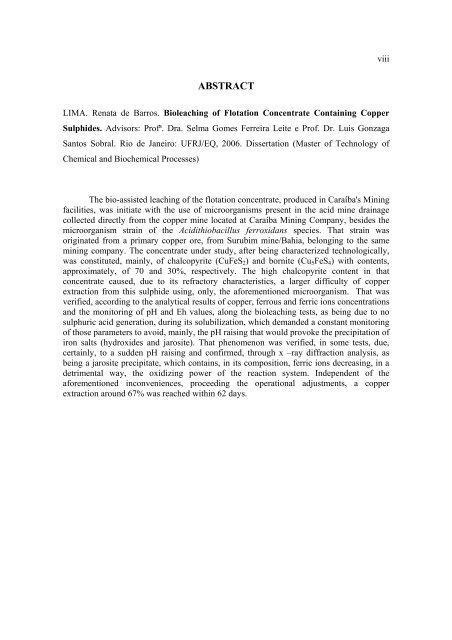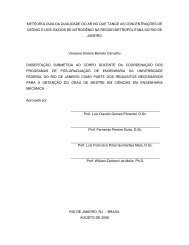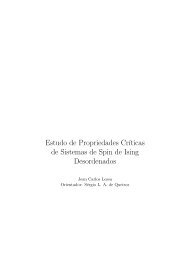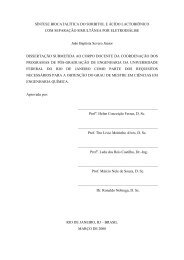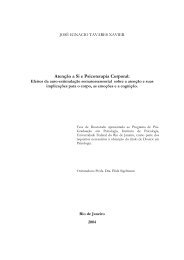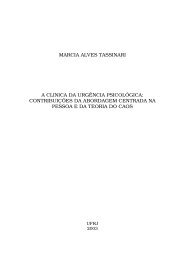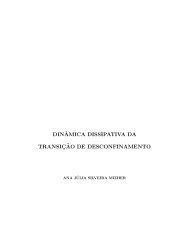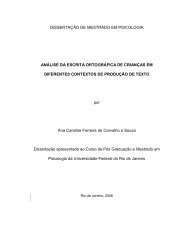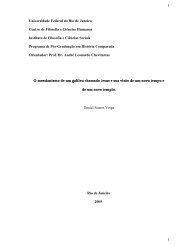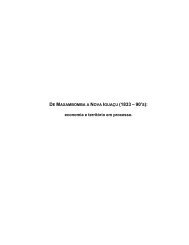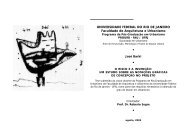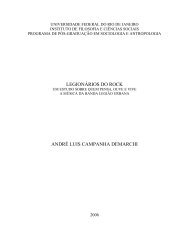Renata de Barros Lima - UFRJ
Renata de Barros Lima - UFRJ
Renata de Barros Lima - UFRJ
Create successful ePaper yourself
Turn your PDF publications into a flip-book with our unique Google optimized e-Paper software.
ABSTRACT<br />
LIMA. <strong>Renata</strong> <strong>de</strong> <strong>Barros</strong>. Bioleaching of Flotation Concentrate Containing Copper<br />
Sulphi<strong>de</strong>s. Advisors: Profª. Dra. Selma Gomes Ferreira Leite e Prof. Dr. Luis Gonzaga<br />
Santos Sobral. Rio <strong>de</strong> Janeiro: <strong>UFRJ</strong>/EQ, 2006. Dissertation (Master of Technology of<br />
Chemical and Biochemical Processes)<br />
The bio-assisted leaching of the flotation concentrate, produced in Caraíba's Mining<br />
facilities, was initiate with the use of microorganisms present in the acid mine drainage<br />
collected directly from the copper mine located at Caraíba Mining Company, besi<strong>de</strong>s the<br />
microorganism strain of the Acidithiobacillus ferroxidans species. That strain was<br />
originated from a primary copper ore, from Surubim mine/Bahia, belonging to the same<br />
mining company. The concentrate un<strong>de</strong>r study, after being characterized technologically,<br />
was constituted, mainly, of chalcopyrite (CuFeS2) and bornite (Cu5FeS4) with contents,<br />
approximately, of 70 and 30%, respectively. The high chalcopyrite content in that<br />
concentrate caused, due to its refractory characteristics, a larger difficulty of copper<br />
extraction from this sulphi<strong>de</strong> using, only, the aforementioned microorganism. That was<br />
verified, according to the analytical results of copper, ferrous and ferric ions concentrations<br />
and the monitoring of pH and Eh values, along the bioleaching tests, as being due to no<br />
sulphuric acid generation, during its solubilization, which <strong>de</strong>man<strong>de</strong>d a constant monitoring<br />
of those parameters to avoid, mainly, the pH raising that would provoke the precipitation of<br />
iron salts (hydroxi<strong>de</strong>s and jarosite). That phenomenon was verified, in some tests, due,<br />
certainly, to a sud<strong>de</strong>n pH raising and confirmed, through x –ray diffraction analysis, as<br />
being a jarosite precipitate, which contains, in its composition, ferric ions <strong>de</strong>creasing, in a<br />
<strong>de</strong>trimental way, the oxidizing power of the reaction system. In<strong>de</strong>pen<strong>de</strong>nt of the<br />
aforementioned inconveniences, proceeding the operational adjustments, a copper<br />
extraction around 67% was reached within 62 days.<br />
viii


